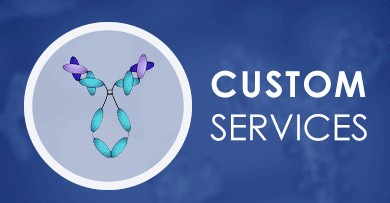 Loading...
Loading...

CLDN4
 Loading...
Loading...Anti-CLDN4 Products
- Anti-Human CLDN4 Recombinant Antibody (KM3900) (TAB-501LC)
-
- Application: WB, IP, FC
-
- Species Reactivity: Mouse
- Application: FC
- Anti-Human CLDN4 Recombinant Antibody (KM3907) (TAB-504LC)
-
- Application: Cyt, FC, WB
- Human Anti-CLDN4 Antibody, mRNA (TAB-169CL-mRNA)
-
- Species Reactivity: Human
-
- Derivation: Humanized
- Species Reactivity: Human
- Type: ADCC enhanced antibody
- Anti-Human CLDN4 Recombinant Antibody (TAB-169CL)
-
- Derivation: Humanized
- Species Reactivity: Human
- Type: Antibody
-
- Derivation: Humanized
- Type: Humanized antibody
- Application: Cyt, FC, WB
-
- Derivation: Humanized
- Type: Humanized antibody
-
- Derivation: Humanized
- Type: Humanized antibody
- Anti-Human CLDN4 Recombinant Antibody scFv Fragment (cKM3907) (TAB-505LC-S(P))
-
- Derivation: Chimeric (mouse/human)
- Type: Chimeric antibody (mouse/human)
- Anti-Human CLDN4 Recombinant Antibody Fab Fragment (cKM3900) (TAB-502LC-F(E))
-
- Derivation: Chimeric (mouse/human)
- Type: Chimeric antibody (mouse/human)
- Anti-Human CLDN4 Recombinant Antibody scFv Fragment (cKM3900) (TAB-502LC-S(P))
-
- Derivation: Chimeric (mouse/human)
- Type: Chimeric antibody (mouse/human)
- Anti-Human CLDN4 Recombinant Antibody (cKM3907) (TAB-505LC)
-
- Derivation: Chimeric (mouse/human)
- Type: Chimeric antibody (mouse/human)
- Application: Cyt, FC, WB
- Anti-Human CLDN4 Recombinant Antibody (cKM3900) (TAB-502LC)
-
- Derivation: Chimeric (mouse/human)
- Type: Chimeric antibody (mouse/human)
- Application: Cyt, FC, WB
- Anti-Human CLDN4 Recombinant Antibody Fab Fragment (cKM3907) (TAB-505LC-F(E))
-
- Derivation: Chimeric (mouse/human)
- Type: Chimeric antibody (mouse/human)
-
- Species Reactivity: Human, Mouse
- Type: Mouse IgG
- Application: IHC-P, IF
-
- Species Reactivity: Human, Mouse
- Type: Mouse IgG
- Application: IHC-P, IF
-
- Species Reactivity: Human
- Type: Rabbit IgG
- Application: WB, IHC-P, IP
-
- Derivation: Mouse
- Species Reactivity: Human
- Type: Mouse IgG1
- Application: IHC, IF, WB
-
- Derivation: Human
- Species Reactivity: Human
- Type: Human IgG1
- Application: ELISA
-
- Species Reactivity: Human
- Type: Mouse IgG2b
- Application: IHC-P
-
- Species Reactivity: Human
- Type: Mouse IgG2b
- Application: WB, IHC
-
- Species Reactivity: Human
- Type: Mouse IgG2b, κ
- Application: WB, IHC-P
-
- Species Reactivity: Human
- Type: Mouse IgG2b, κ
- Application: WB, IHC-P
-
- Species Reactivity: Human
- Type: Rabbit IgG
- Application: ELISA
- Anti-Human CLDN4 Recombinant Antibody Fab Fragment (TAB-506LC-F(E)) (TAB-506LC-F(E))
-
- Species Reactivity: Mouse
- Anti-Human CLDN4 Recombinant Antibody scFv Fragment (KM3900) (TAB-501LC-S(P))
-
- Application: WB, IP
- Anti-Human CLDN4 Recombinant Antibody Fab Fragment (KM3900) (TAB-501LC-F(E))
-
- Application: WB, IP
- Anti-Human CLDN4 Recombinant Antibody scFv Fragment (TAB-506LC-S(P)) (TAB-506LC-S(P))
-
- Species Reactivity: Mouse
- Anti-Human CLDN4 Recombinant Antibody scFv Fragment (KM3907) (TAB-504LC-S(P))
-
- Application: WB, IP
- Anti-Human CLDN4 Recombinant Antibody Fab Fragment (KM3907) (TAB-504LC-F(E))
-
- Application: WB, IP
-
- Species Reactivity: Mouse
- Target: CLDN4
- Host Animal: Rat
- Application: ELISA, FC, Cell-uptake
- Anti-CLDN4 Immunohistochemistry Kit (VS-0525-XY1487)
-
- Species Reactivity: Human
- Target: CLDN4
- Application: IHC
Can't find the products you're looking for? Try to filter in the left sidebar.Filter By Tag
Our customer service representatives are available 24 hours a day, from Monday to Sunday. Contact Us
For Research Use Only. Not For Clinical Use.
Background
Cancer-related genes, Disease related genes, Human disease related genes, Potential drug targets, Transporters
Membrane
Cell type enhanced (Urothelial cells, Basal prostatic cells, Glandular and luminal cells, Prostatic glandular cells, Paneth cells)
Not detected in immune cells
Cell line enhanced (A-431, BEWO, CAPAN-2, MCF7, OE19, PC-3, RT4, SK-BR-3)
Directly interacts with TJP1/ZO-1 (PubMed:16236711). Interacts with TJP2/ZO-2 and TJP3/ZO-3 (By similarity). Interacts with EPHA2; phosphorylates CLDN4 and may regulate tight junctions (PubMed:16236711). Interacts with CLDN1 (PubMed:20375010). Interacts with CLDN8 (By similarity). (Microbial infection) Interacts (via both extracellular domains) with Clostridium perfringens enterotoxin CPE; the interaction may disrupt claudin assembly in tight junctions.
Chloride channel, Ion channel



